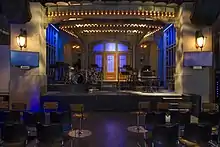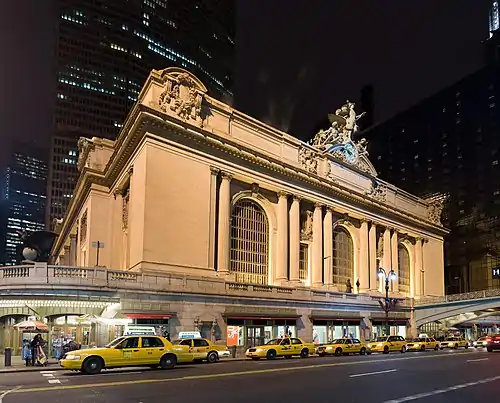Grand Central Terminal in popular culture
Grand Central Terminal, a train station in Manhattan, New York City, has been the subject, inspiration, or setting for literature, television and radio episodes, and films.[1][2]

Film and television

Many film and television productions have included scenes shot in the terminal. The MTA hosts about 25 large-scale and hundreds of smaller or amateur productions every year.[3] Kyle McCarthy, who handles production at Grand Central, said, "Grand Central is one of the quintessential New York places. Whether filmmakers need an establishing shot of arriving in New York or transportation scenes, the restored landmark building is visually appealing and authentic."[4] Especially during World War II, Grand Central has been a backdrop for romantic reunions between couples. After the terminal declined in the 1950s, it was more frequently used as a dark, dangerous place, even a metaphor for chaos and disorientation,[2] featuring chase scenes, shootouts, homeless people, and the mentally ill. In the 1990 film The Freshman, for example, Matthew Broderick's character stumbles over an unconscious man and watches fearfully as petty crimes take place around him.[5]
Almost every scene filmed in the terminal's train shed was shot on Track 34, one of the few areas without view-blocking structural columns.[6][7]
The first filmed scene in which Grand Central Terminal appears may be the 1909 short comedy Mr. Jones Has a Card Party, while still under construction.[8] The terminal's first cinematic appearance was in the 1930 musical film Puttin' On the Ritz,[7] and its first Technicolor appearance was in the 1953 film The Band Wagon.[6] Some films from the 20th century, including Grand Central Murder, The Thin Man Goes Home, Hello, Dolly!, and Beneath the Planet of the Apes used reconstructions of Grand Central, built in Hollywood, to stand in for the terminal.[2][9] The Bollywood film Kabhi Alvida Naa Kehna uses other American train stations standing in for Grand Central.[8] Additionally, the terminal was drawn and animated for use in the animated films Madagascar (2005)[10] and Wreck-It Ralph (2012).[11]
Other films in which the terminal appears include:
- The Breakdown (1912)[8]
- Going Hollywood (1933)[12]
- Hold Your Man (1933)[13][14]
- Twentieth Century (1934)[12]
- Spellbound (1945)[12]
- The Clock (1945)[8]
- Ma and Pa Kettle Go to Town (1950)
- North by Northwest (1959)[12]
- Seconds (1966)[2]
- The Out-of-Towners (1970)[10]
- The French Connection (1971)
- Necrology (1971)[2]
- Superman (1978)[3]
- A Stranger Is Watching (1982)[14]
- Koyaanisqatsi (1982)[8]
- Escape from the Bronx (1983)[8]
- Falling in Love (1984)[12]
- The Cotton Club (1984)[14]
- Chronos (1985)[8]
- Midnight Run (1988)[14]
- The House on Carroll Street (1988)[14]
- Großer Bahnhof (1990)[8]
- Loose Cannons (1990)[14]
- The Fisher King (1991)[2]
- The Prince of Tides (1991)
- Baraka (1992)[8]
- Carlito's Way (1993)[2]
- Hackers (1995)[15]
- One Fine Day (1996)
- The Ice Storm (1997)[12]
- Armageddon (1998)[10]
- Godzilla (1998)[12]
- U.S. Marshals (1998)[12]
- Men in Black II (2002)[3]
- I Am Legend (2007)[10]
- Revolutionary Road (2008)[10]
- Arthur (2011)[2]
- Friends with Benefits (2011)[10]
- The Avengers (2012)[2]
- The Girl on the Train (2016)[3]
- The Commuter (2018)
- John Wick: Chapter 3 (2019)[3]
Notable documentaries about the terminal include Grand Central, a 1982 film narrated by James Earl Jones and featuring Philip Johnson and Ed Koch.[16]

On October 19, 2017, several of these films were screened in the terminal for an event created by the MTA, Rooftop Films, and the Museum of the Moving Image. The event featured a cinematic history lecture by architect and author James Sanders.[17]
Grand Central Terminal's architecture, including its Main Concourse clock, are depicted on the stage of Saturday Night Live, a long-running NBC television show.[8][18] Warren and Wetmore designed The soundstage reconstruction of the terminal in Studio 8H was first installed in 2003.[19][20]
Literature
Literature featuring the terminal includes Report on Grand Central Terminal, written in 1948 by nuclear physicist Leo Szilard; The Catcher in the Rye by J. D. Salinger; The House of Mirth by Edith Wharton; Grand Central Murder by Sue MacVeigh, which was made into the eponymous film in 1942; A Stranger Is Watching by Mary Higgins Clark;[8] and the 1946 children's classic The Taxi That Hurried by Lucy Sprague Mitchell.[1] The infrastructure in Grand Central inspired the novel The Invention of Hugo Cabret, and in turn, the film Hugo.[21] The dangerous life of homeless men and women in Grand Central and its tunnels and passageways inspired Lee Stringer's Grand Central Winter: Stories from the Street and Tina S.'s collaboration with journalist Jamie Pastor Bolnick in the autobiography Living at the Edge of the World: A Teenager's Survival in the Tunnels of Grand Central Station.[22][23]
Art
Other works
Grand Central Station, an NBC radio drama set at the terminal, ran from 1937 to 1953.[8] Among the video games that feature the terminal are Marvel's Spider-Man, True Crime: New York City, and Tom Clancy's The Division.[24]
A Lego replica of the terminal is situated in Miniland USA, an exhibit at Legoland California. The cutaway model shows elaborate interior details of the station building.[25]
References
Notes
- Roberts, Sam (January 22, 2013). Grand Central: How a Train Station Transformed America. Grand Central Publishing. ISBN 978-1-4555-2595-9.
- "Grand Central Terminal's Ten Greatest Moments on Film". The Bowery Boys: New York City History. February 21, 2018. Archived from the original on December 5, 2018. Retrieved December 6, 2018.
- "Oscar Ready Digs at GCT!". Mileposts. Metropolitan Transportation Authority. August 2019. Archived from the original on August 19, 2019. Retrieved September 5, 2019.
- "Industry Star of the Month". Mayor's Office of Film, Theatre & Broadcasting. October 1, 2005. Archived from the original on February 15, 2019. Retrieved February 14, 2019.
- Dunlap, David W. (July 5, 2017). "In a 'Summer of Hell,' Grand Central May Be a Bit of Heaven". The New York Times. ISSN 0362-4331. Archived from the original on December 20, 2018. Retrieved December 19, 2018.
- Carlson, Jen (May 12, 2015). "Everything You Never Knew You Wanted To Know About Grand Central Terminal". Gothamist. Archived from the original on October 7, 2018. Retrieved January 5, 2019.
- Chaudhury, Nadia (January 27, 2013). "12 things you didn't know about Grand Central Terminal". Time Out New York. Archived from the original on December 7, 2018. Retrieved December 6, 2018.
- Langmead 2009, pp. 165–166.
- Winogura, Dale (1972). "Dialogues on Apes, Apes, and More Apes" (PDF). Cinefantastique: Planet of the Apes Issue. p. 37. Archived (PDF) from the original on July 16, 2012. Retrieved December 24, 2018.
- Rosen, Neil. "The Grand Central Terminal in the Movies". NY1. Archived from the original on December 12, 2021. Retrieved December 6, 2018.
- Puig, Claudia (November 1, 2012). "'Wreck-It Ralph' dazzles in the Disney way". USA Today. Archived from the original on June 13, 2020. Retrieved June 13, 2020.
- "Hollywood Visits Grand Central". The Reporter Dispatch. September 27, 1998. p. 4C. Archived from the original on February 12, 2023. Retrieved February 12, 2023.
- "Hold Your Man (1933)". AFI Catalog of Feature Films. American Film Institute. Archived from the original on February 10, 2022. Retrieved February 10, 2022.
- "Great Performances". The Palm Beach Post. August 7, 1988. Archived from the original on February 12, 2023. Retrieved February 12, 2023.
- Kreps, Daniel (March 9, 2020). "Hear David Gilmour, Guy Pratt's Unreleased Song From 'Hackers' Soundtrack". Rolling Stone. Archived from the original on February 13, 2023. Retrieved February 13, 2023.
- Dunlop, Beth (June 29, 1983). "In praise of Grand Central". The Miami Herald. Archived from the original on February 13, 2023. Retrieved February 13, 2023 – via Newspapers.com.
- Weaver, Shaye (October 11, 2017). "Grand Central Terminal transforming into cinema for one day only". AM New York. Archived from the original on May 12, 2019. Retrieved December 6, 2018.
- Baker, R.C. (May 19, 2017). "Meet SNL's 78-Year-Old "Heart Of The Show"". Village Voice. Archived from the original on December 9, 2018. Retrieved December 8, 2018.
- Sachs, Andrea (February 21, 2013). "Meet me at Grand Central for the 100th". The Washington Post. Archived from the original on January 30, 2021. Retrieved November 21, 2020.
- "SNL primed for 29". Variety. September 25, 2003. Archived from the original on January 30, 2021. Retrieved November 21, 2020.
- "Exploring Grand Central's Secrets, With the Author of Hugo Cabret – New York Public Radio, Podcasts, Live Streaming Radio, News". WNYC. January 6, 2012. Archived from the original on January 24, 2019. Retrieved January 24, 2019.
- Jiler, John (June 28, 1998). "Street Singer". Movies. The New York Times. Archived from the original on February 17, 2019. Retrieved February 17, 2019.
- Levinson, D.; Gale Group; Sage Publications (2004). Encyclopedia of Homelessness. A Berkshire reference work. SAGE Publications. p. 25. ISBN 978-0-7619-2751-8. Archived from the original on February 17, 2023. Retrieved February 17, 2019.
- Langmead 2009, p. 167.
- "Matter". Interiors. 158: 71. July 1999. Archived from the original on 2023-02-17. Retrieved 2023-02-13.
Sources
- Langmead, Donald (2009). Icons of American Architecture: From the Alamo to the World Trade Center. Greenwood Icons. Greenwood Press. ISBN 978-0-313-34207-3.

